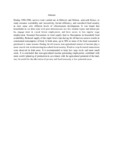| dc.description.abstract | During 1994-1996, surveys were carried out in Kibwezi and Kilome, semi-arid Kenya, to study resource availability and productivity, farmer efficiency, and household food security in rural areas with different levels of infrastructure development. It was found that households in the drier zone with poor infrastructure use less modern inputs and labour per ha, engage more in casual labour employment, and have access to less regular wage employment. Seasonal fluctuations in food supply lead to fluctuations in household food availability. Reduced supply of the staple food crops during the off-harvest seasons results in constrained consumption of food. In both areas, up to 50% or more of the food consumed is purchased in some seasons. During the off-season, non-agricultural sources of income play a more crucial role in determining household food security. Positive crop-livestock interactions were observed in both areas. It is recommended to keep less large stock and more small stock. It is concluded that non-agricultural income generating employment, combined with more careful planning of production in accordance with the agricultural potential of the land, may be useful for the alleviation of poverty and food insecurity in low potential areas. | en_US |

